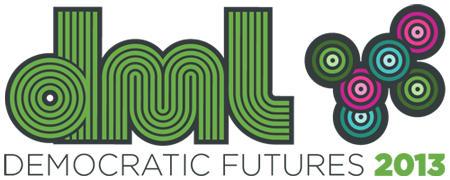DML: HOMAGO for All: Applying HOMAGO Principles to Different Spaces
Staff from two YOUmedia early adopter sites, Hirshhorn’s ARTLAB+ and DreamYard, come together to lead a workshop that explores how different institutional constraints affect the application of HOMAGO principles in digital learning environments.
The workshop will consist of three sections:
I. Experience Hanging Out and Messing Around at DML (20 minutes)
II. ARTLAB+ and DreamYard present about HOMAGO at their sites (20 minutes)
III. Create a HOMAGO model (50 minutes)
In Part I, participants will experience Hanging Out and Messing Around firsthand. The room will be set up with both peer and interest-driven activities which have been tested at our YOUmedia sites and that encourage interaction. Upon entry, participants will be able to visit three unique activity stations, including ones that let participants use facebook and video games to ones that can teach them "How to Make a GIF" and "How to Make Beats." Participants are free to explore for a period of time what these activity stations offer them. There will be two to three staff members from the two hosting YOUmedia early adopter sites to encourage and guide the participants experience.
In Part II, Ryan Hill, from ARTLAB+, and Hillary Kolos, from DreamYard, will transition the group from hanging out and messing around to geeking out – about HOMAGO. ARTLAB+ and DreamYard exemplify two different ways that sites have incorporated the same HOMAGO principles. Ryan and Hillary will each give 10-minute presentations about how different constraints at their institution affect how HOMAGO principles are implemented into their programming. These constraints include space, mission/history, audience, and time. The presentations will serve as examples to ground the group activity in Part III.
In Part III, the tables will turn and participants will be asked to problem solve how to implement HOMAGO principles at a new (fictional) institution. The room will be split into groups of four and each will receive large post-it pads, markers, and a template of several “institutional constraints.” This exercise will get groups brainstorming about what HOMAGO might look like at their fictional institution and how it might work for their (fictional) audiences.
For example, one group might be given slips of paper describing an institution:
• Type of institution: A museum
• Time: Saturday programs
• Space: Three rooms, one with 10 desktop computers
• Content Area: African American History
• Audience: Teens who can reach a downtown urban area
With this information the groups will think about how they would create new programming for hanging out, messing around, and geeking out within the given institutional constraints. Then, each group will be asked to present their ideas for new HOMAGO-inspired programming at their fictional institution.
Overall, this workshop will allow participants to experience hanging out and messing around, hear from program directors about their experience incorporating HOMAGO principles at their institutions, and problem solve how to apply HOMAGO principles at other institutions. Our goal is to help people understand that the underlying principles for HOMAGO can exist in any kind of unique space and work within the constraints of their institution.



